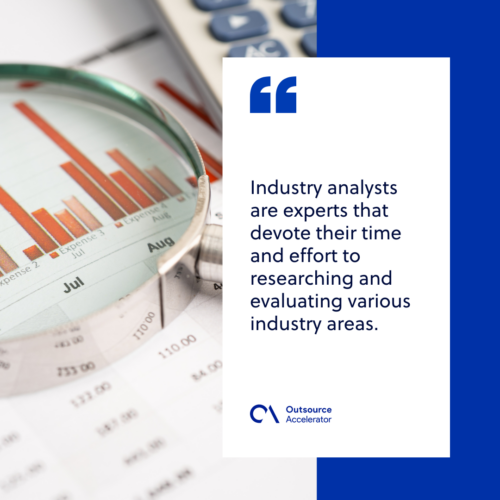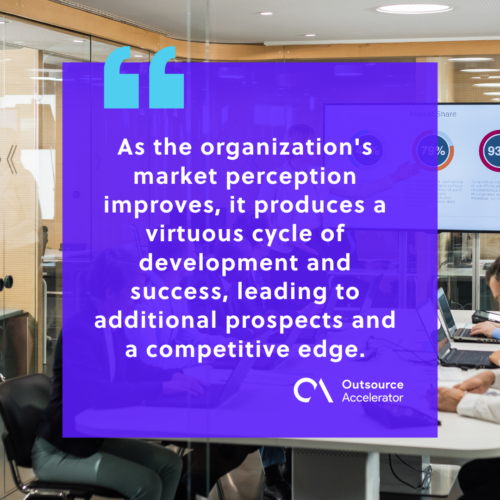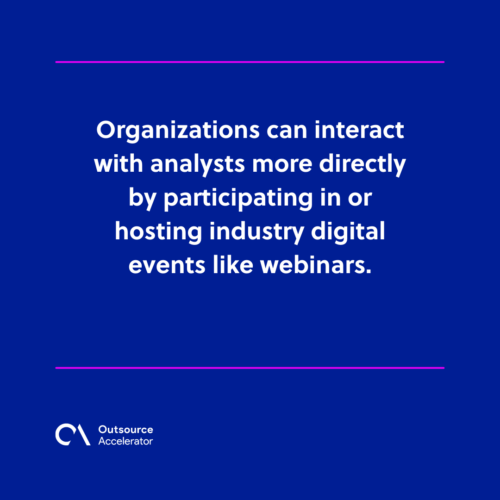Nurturing valuable partnerships with analyst relations

Businesses get more credibility when they build trust with their stakeholders, partners, and clients.
Firms with a solid reputation in the market are more likely to draw in and keep consumers, develop relationships that benefit both parties, and enjoy success overall.
Strong ties with vendors and other business associates build a network of assistance that supports enterprises in adjusting to the shifting market conditions. One key aspect of achieving this is building partnerships with industry analysts.
Analyst relations are crucial in enhancing market perception, increasing credibility, and providing access to industry trends and forecasts.
These connections can give the company access to resources, alternative solutions, and cooperative problem-solving during economic stress or uncertainty.
This article discusses analyst relations and how they strengthen the organization’s resilience and build strong partnerships.
What are analyst relations?
Analyst relations is the deliberate cultivation and maintenance of connections between corporations and industry analysts. This practice is critical to a company’s overall strategy for managing stakeholder relationships.
Industry analysts are experts that devote their time and effort to researching and evaluating various industry areas.
Organizations employ industry analysts to help them make educated decisions, develop successful strategies, and validate their market presence.
Their extensive experience and insights into various sectors make them great resources for businesses looking for advice, suggestions, and market projections.
Companies may tap into these individuals’ expertise and experience by cultivating strong analyst relations.

Roles of an industry analyst
Industry analysts typically fulfill three primary roles:
Prescribers
Prescribers play an important role in honing strong analyst relations by making suggestions to companies and clients based on comprehensive study and analysis.
These experts have in-depth knowledge of the sector and its dynamics. Prescribers assist organizations in identifying possibilities and assessing risks. Their insights and practical suggestions are critical in defining firms’ goals and investments.
Prescribers serve as trusted consultants, encouraging firms to make informed decisions that can lead to development and success.
Number crunchers
Industry analysts who examine market data, financial data, and industry statistics are known as number crunchers. They assist firms in making data-driven choices by mining massive databases for insightful information.
To spot trends, patterns, and important indicators, these analysts use a variety of approaches like statistical analysis, modeling, and forecasting.
Number crunchers help firms thoroughly grasp their market position and competitive environment by evaluating and contextualizing numerical information.
Utilizing the skills of number crunchers allows businesses to maximize operations, seize market opportunities, and maintain solid analyst relations.
Vendor-facing
Vendor-facing analysts are experts in evaluating technology suppliers, goods, and services within a certain sector.
These analysts assist organizations in understanding the competitive landscape by performing a detailed market analysis.
Vendor-facing analysts work as go-betweens for technology suppliers and potential consumers, allowing both parties to understand the market situation better.
4 benefits of strong analyst relations
Developing and maintaining excellent connections with industry analysts may provide various advantages to firms:
Here are the four benefits of having strong analyst relations:
1. Enhanced market perception and reputation
Developing good analyst relations with reputable industry experts helps an organization’s market perception and reputation.
Analysts’ suggestions and endorsements have weight and influence in the market, and when they talk highly about a company, it may have a significant impact.
Organizations gain awareness, credibility, and legitimacy by being connected with prominent analysts, portraying themselves as trusted leaders in their area. This good reputation can entice potential clients, investors, and partners.
As the organization’s market perception improves, it produces a virtuous cycle of development and success, leading to additional prospects and a competitive edge.

2. Increased credibility and validation
Exceptional analyst relations increase the company’s credibility in the eyes of clients, prospects, and stakeholders. This validation distinguishes the company from rivals and fosters client confidence.
Organizations with improved public image gain new business opportunities, develop collaborations, and retain existing clients.
3. Improved decision-making
As mentioned earlier, analysts have comprehensive research findings, profound experience, and industry understanding. By using this information, organizations may make data-driven decisions.
4. Access to industry trends and forecasts
Industry analysts have wide access to market data, trends, and projections. Organizations may acquire this essential market knowledge by forming good analyst relations.
This also allows businesses to:
- Remain current with the newest trends
- Predict market developments
- Adjust their tactics appropriately
Companies may find new possibilities proactively, assess client wants, and connect their offers with market expectations.
Organizations can acquire a competitive advantage in their respective sectors by developing a robust analyst relations foundation. This alliance allows firms to demonstrate competence and build client confidence.
How can businesses build strong analyst relations?
To build and maintain robust business partnerships with industry leaders and other stakeholders, take note of the following key steps:
Identifying the right analysts
Identifying experts’ specializations for a specific industry or market area is the first stage in developing analyst relations.
Investigate and assess analysts’ areas of expertise, reputation, and relevance to the organization’s goals. This fosters strategic alignment and creates the groundwork for a productive collaboration.
Establishing initial contact
Once the relevant analysts have been identified, organizations should establish initial contact.
This can be done through the following:
- Attending industry conferences
- Reaching out via email or social media
- Leveraging existing professional networks
When reaching out, it is essential to provide a clear and concise introduction, highlight the organization’s value proposition, and explain the purpose of the engagement.
Involvement in industry events
Organizations can interact with analysts more directly by participating in or hosting industry digital events like webinars.
Industry leaders may demonstrate their knowledge and establish relationships with analysts by providing insights or participating in panel discussions. Through these exchanges, analyst relations are built on trust, and respect is fostered.

Collaborative research projects
Working on research projects with industry analysts is a good idea to strengthen analyst relations.
Organizations and analysts can collaborate on specific areas of interest, with the former contributing their domain and data knowledge. The latter, on the other hand, share their experience and market insights.
This cooperation improves the relationship and results in useful publications and reports that are advantageous to both sides.
Regular briefings and updates
To maintain well-grounded analyst relations, firms must continue communication with analysts and give frequent briefings and updates about their business initiatives and plans.
This guarantees that analysts have correct and up-to-date information, allowing them to give timely and relevant insights.
Analyst relations: In a nutshell
Analyst relations are critical in forming and sustaining productive collaborations between corporations and industry analysts.
By cultivating these partnerships, organizations may benefit from improved market perception, more credibility, better decision-making, and access to industry trends and projections.







 Independent
Independent




